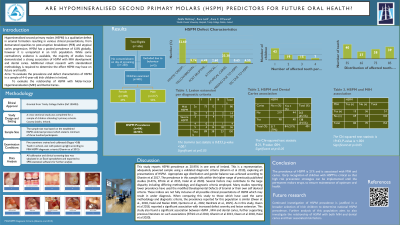Other
2 - Are Hypomineralised Second Primary Molars (HSPM) Predictors for Future Oral Health?


Hugh D. McGrory, B.Dent.Sc MFD(RCSI) (he/him/his)
Paediatric Dental Resident
Dublin Dental University Hospital, Trinity College Dublin
Dublin, Dublin, Ireland
Anne C. O' Connell, BA, BDent, MS (U. Roch)
Professor Pediatric Detistry
Trinity College Dublin, Dublin, Ireland
Trinity College Dublin
DUblin 2, Dublin, Ireland
Presenting Author(s)
Program Director(s)
Purpose: The aim of this study is to investigate the prevalence and characteristics of HSPM and to assess its association with dental caries and Molar Incisor Hypomineralisation (MIH).
Methods: Following ethical approval, a cross-sectional study was completed for children aged 4-6 years, investigating clinical characteristics of HSPM, MIH and dental caries. Participants were examined in school settings using the MIH/HSPM and dV3mft diagnostic criteria. Five examiners were trained and calibrated for each standardized index (kappa >0.80). The clinical examination was accompanied by a parental questionnaire.
Results: A total of 401 children were examined [Age-Mean(SD)= 5.4(0.68); Males=53%]. Eighty-four children (Males=58%) had HSPM defects resulting in a prevalence of 21%. Most participants had only one affected primary molar (51%). Demarcated opacities were the most common lesion (62%), followed by atypical caries (23%), post-eruptive breakdown (6%), atypical restoration (2%). Lesion extension and severity were significantly related (P < .001). Only 43% children had at least one erupted permanent molar, of which 51 had MIH defects, giving a prevalence of MIH as 29%. The co-occurrence of MIH and HSPM was 10%. The caries prevalence was 34%. The whole sample mean dV3mft was 1.3, and 92% was untreated. A significant relationship was noted between HSPM, dental caries (P= .004) and MIH (P < .001).
Conclusion: The prevalence of HSPM is 21% and is associated with MIH and caries. Early recognition of children with HSPM is critical so that high risk prevention strategies can be implemented until the permanent molars erupt, to ensure maintenance of optimum oral health.
Identify Supporting Agency and Grant Number:

.jpg)